《人与环境 Human and Environment》课程教学资源(阅读材料)UNEP and the Green Economy - 40 years in development
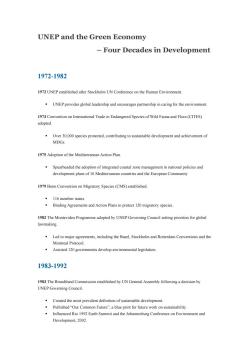
UNEP and the Green Economy Four Decades in Development 1972-1982 1972 UNEP established after Stockholm UN Conference on the Human Environment UNEP provides global leadership and encourages partnership in caring for the environment. 1973 Convention on International Trade in Endangered Species of Wild Fauna and Flora(CITES) adopted. "Over 30,000 species protected,contributing to sustainable development and achievement of MDGs 1975 Adoption of the Mediterranean Action Plan. "Spearheaded the adoption of integrated coastal zone management in national policies and development plans of 16 Mediterranean countries and the European Community 1979 Bonn Convention on Migratory Species(CMS)established. ■116 member states. .Binding Agreements and Action Plans to protect 120 migratory species. 1982 The Montevideo Programme adopted by UNEP Governing Council setting priorities for global lawmaking. Led to major agreements,including the Basel,Stockholm and Rotterdam Conventions and the Montreal Protocol. "Assisted 120 governments develop environmental legislation. 1983-1992 1983 The Brundtland Commission established by UN General Assembly following a decision by UNEP Governing Council. "Created the most prevalent definition of sustainable development. "Published "Our Common Future",a blue print for future work on sustainability Influenced Rio 1992 Earth Summit and the Johannesburg Conference on Environment and Development.2002
UNEP and the Green Economy – Four Decades in Development 1972-1982 1972 UNEP established after Stockholm UN Conference on the Human Environment. UNEP provides global leadership and encourages partnership in caring for the environment. 1973 Convention on International Trade in Endangered Species of Wild Fauna and Flora (CITES) adopted. Over 30,000 species protected, contributing to sustainable development and achievement of MDGs. 1975 Adoption of the Mediterranean Action Plan. Spearheaded the adoption of integrated coastal zone management in national policies and development plans of 16 Mediterranean countries and the European Community 1979 Bonn Convention on Migratory Species (CMS) established. 116 member states. Binding Agreements and Action Plans to protect 120 migratory species. 1982 The Montevideo Programme adopted by UNEP Governing Council setting priorities for global lawmaking. Led to major agreements, including the Basel, Stockholm and Rotterdam Conventions and the Montreal Protocol. Assisted 120 governments develop environmental legislation. 1983-1992 1983 The Brundtland Commission established by UN General Assembly following a decision by UNEP Governing Council. Created the most prevalent definition of sustainable development. Published “Our Common Future”, a blue print for future work on sustainability. Influenced Rio 1992 Earth Summit and the Johannesburg Conference on Environment and Development, 2002
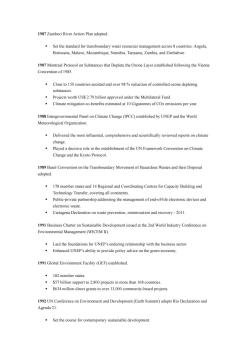
1987 Zambezi River Action Plan adopted. "Set the standard for transboundary water resources management across 8 countries:Angola, Botswana,Malawi,Mozambique,Namibia,Tanzania,Zambia,and Zimbabwe. 1987 Montreal Protocol on Substances that Deplete the Ozone Layer established following the Vienna Convention of 1985. "Close to 150 countries assisted and over 98%reduction of controlled ozone depleting substances. Projects worth US$2.79 billion approved under the Multilateral Fund. Climate mitigation co-benefits estimated at 10 Gigatonnes of CO2 emissions per year. 1988 Intergovernmental Panel on Climate Change(IPCC)established by UNEP and the World Meteorological Organization "Delivered the most influential,comprehensive and scientifically reviewed reports on climate change "Played a decisive role in the establishment of the UN Framework Convention on Climate Change and the Kyoto Protocol. 1989 Basel Convention on the Transboundary Movement of Hazardous Wastes and their Disposal adopted. 178 member states and 14 Regional and Coordinating Centres for Capacity Building and Technology Transfer,covering all continents. Public-private partnership addressing the management of end-of-life electronic devices and electronic waste. "Cartagena Declaration on waste prevention.minimization and recovery-2011. 1991 Business Charter on Sustainable Development issued at the 2nd World Industry Conference on Environmental Management(WICEM II). "Laid the foundations for UNEP's enduring relationship with the business sector. Enhanced UNEP's ability to provide policy advice on the green economy. 1991 Global Environment Facility (GEF)established. 182 member states. $57 billion support to 2,800 projects in more than 168 countries. $634 million direct grants to over 13.000 community-based projects. 1992 UN Conference on Environment and Development(Earth Summit)adopts Rio Declaration and Agenda 21. "Set the course for contemporary sustainable development
1987 Zambezi River Action Plan adopted. Set the standard for transboundary water resources management across 8 countries: Angola, Botswana, Malawi, Mozambique, Namibia, Tanzania, Zambia, and Zimbabwe. 1987 Montreal Protocol on Substances that Deplete the Ozone Layer established following the Vienna Convention of 1985. Close to 150 countries assisted and over 98 % reduction of controlled ozone depleting substances. Projects worth US$ 2.79 billion approved under the Multilateral Fund. Climate mitigation co-benefits estimated at 10 Gigatonnes of CO₂ emissions per year. 1988 Intergovernmental Panel on Climate Change (IPCC) established by UNEP and the World Meteorological Organization. Delivered the most influential, comprehensive and scientifically reviewed reports on climate change. Played a decisive role in the establishment of the UN Framework Convention on Climate Change and the Kyoto Protocol. 1989 Basel Convention on the Transboundary Movement of Hazardous Wastes and their Disposal adopted. 178 member states and 14 Regional and Coordinating Centres for Capacity Building and Technology Transfer, covering all continents. Public-private partnership addressing the management of end-of-life electronic devices and electronic waste. Cartagena Declaration on waste prevention, minimization and recovery - 2011. 1991 Business Charter on Sustainable Development issued at the 2nd World Industry Conference on Environmental Management (WICEM II). Laid the foundations for UNEP’s enduring relationship with the business sector. Enhanced UNEP’s ability to provide policy advice on the green economy. 1991 Global Environment Facility (GEF) established. 182 member states. $57 billion support to 2,800 projects in more than 168 countries. $634 million direct grants to over 13,000 community-based projects. 1992 UN Conference on Environment and Development (Earth Summit) adopts Rio Declaration and Agenda 21. Set the course for contemporary sustainable development
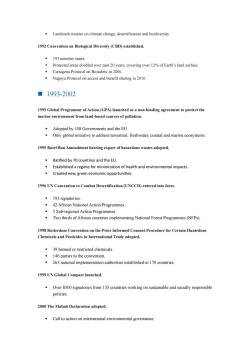
"Landmark treaties on climate change,desertification and biodiversity. 1992 Convention on Biological Diversity (CBD)established. 193 member states. Protected areas doubled over past 20 years,covering over 12%of Earth's land surface. Cartagena Protocol on Biosafety in 2000. "Nagoya Protocol on access and benefit sharing in 2010. ■1993-2002 1995 Global Programme of Action(GPA)launched as a non-binding agreement to protect the marine environment from land-based sources of pollution. Adopted by 108 Governments and the EU. Only global initiative to address terrestrial,freshwater,coastal and marine ecosystems. 1995 Basel Ban Amendment barring export of hazardous wastes adopted. Ratified by 70 countries and the EU. Established a regime for minimization of health and environmental impacts. Created new,green economic opportunities 1996 UN Convention to Combat Desertification (UNCCD)entered into force. ·193 signatories. 42 African National Action Programmes. 5 Sub-regional Action Programmes. Two thirds of African countries implementing National Forest Programmes(NFPs). 1998 Rotterdam Convention on the Prior Informed Consent Procedure for Certain Hazardous Chemicals and Pesticides in International Trade adopted. "39 banned or restricted chemicals. .146 parties to the convention. .265 national implementation authorities established in 170 countries 1999 UN Global Compact launched. Over 8500 signatories from 135 countries working on sustainable and socially responsible policies 2000 The Malmo Declaration adopted. "Call to action on international environmental governance
Landmark treaties on climate change, desertification and biodiversity. 1992 Convention on Biological Diversity (CBD) established. 193 member states. Protected areas doubled over past 20 years, covering over 12% of Earth’s land surface. Cartagena Protocol on Biosafety in 2000. Nagoya Protocol on access and benefit sharing in 2010. 1993-2002 1995 Global Programme of Action (GPA) launched as a non-binding agreement to protect the marine environment from land-based sources of pollution. Adopted by 108 Governments and the EU. Only global initiative to address terrestrial, freshwater, coastal and marine ecosystems. 1995 Basel Ban Amendment barring export of hazardous wastes adopted. Ratified by 70 countries and the EU. Established a regime for minimization of health and environmental impacts. Created new, green economic opportunities. 1996 UN Convention to Combat Desertification (UNCCD) entered into force. 193 signatories. 42 African National Action Programmes. 5 Sub-regional Action Programmes. Two thirds of African countries implementing National Forest Programmes (NFPs). 1998 Rotterdam Convention on the Prior Informed Consent Procedure for Certain Hazardous Chemicals and Pesticides in International Trade adopted. 39 banned or restricted chemicals. 146 parties to the convention. 265 national implementation authorities established in 170 countries. 1999 UN Global Compact launched. Over 8500 signatories from 135 countries working on sustainable and socially responsible policies. 2000 The Malmö Declaration adopted. Call to action on international environmental governance
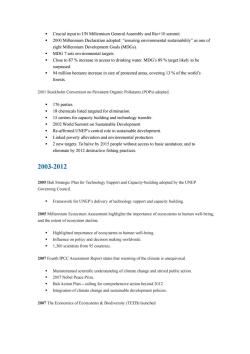
Crucial input to UN Millennium General Assembly and Rio+10 summit. 2000 Millennium Declaration adopted:"ensuring environmental sustainability"as one of eight Millennium Development Goals (MDGs). .MDG 7 sets environmental targets. Close to 87%increase in access to drinking water.MDG's 89%target likely to be surpassed "94 million hectares increase in size of protected areas,covering 13%of the world's forests 2001 Stockholm Convention on Persistent Organic Pollutants(POPs)adopted. 。176 parties. "18 chemicals listed targeted for elimination 15 centres for capacity building and technology transfer. 2002 World Summit on Sustainable Development Re-affirmed UNEP's central role in sustainable development. Linked poverty alleviation and environmental protection. 2 new targets:To halve by 2015 people without access to basic sanitation;and to eliminate by 2012 destructive fishing practices. 2003-2012 2005 Bali Strategic Plan for Technology Support and Capacity-building adopted by the UNEP Governing Council. "Framework for UNEP's delivery of technology support and capacity building. 2005 Millennium Ecosystem Assessment highlights the importance of ecosystems to human well-being, and the extent of ecosystem decline Highlighted importance of ecosystems to human well-being. Influence on policy and decision making worldwide. 1.360 scientists from 95 countries. 2007 Fourth IPCC Assessment Report states that warming of the climate is unequivocal. .Mainstreamed scientific understanding of climate change and stirred public action. 2007 Nobel Peace Prize. Bali Action Plan-calling for comprehensive action beyond 2012. Integration of climate change and sustainable development policies. 2007 The Economics of Ecosystems Biodiversity (TEEB)launched
Crucial input to UN Millennium General Assembly and Rio+10 summit. 2000 Millennium Declaration adopted: “ensuring environmental sustainability” as one of eight Millennium Development Goals (MDGs). MDG 7 sets environmental targets. Close to 87 % increase in access to drinking water. MDG’s 89 % target likely to be surpassed. 94 million hectares increase in size of protected areas, covering 13 % of the world’s forests. 2001 Stockholm Convention on Persistent Organic Pollutants (POPs) adopted. 176 parties. 18 chemicals listed targeted for elimination. 15 centres for capacity building and technology transfer. 2002 World Summit on Sustainable Development Re-affirmed UNEP’s central role in sustainable development. Linked poverty alleviation and environmental protection. 2 new targets: To halve by 2015 people without access to basic sanitation; and to eliminate by 2012 destructive fishing practices. 2003-2012 2005 Bali Strategic Plan for Technology Support and Capacity-building adopted by the UNEP Governing Council. Framework for UNEP’s delivery of technology support and capacity building. 2005 Millennium Ecosystem Assessment highlights the importance of ecosystems to human well-being, and the extent of ecosystem decline. Highlighted importance of ecosystems to human well-being. Influence on policy and decision making worldwide. 1,360 scientists from 95 countries. 2007 Fourth IPCC Assessment Report states that warming of the climate is unequivocal. Mainstreamed scientific understanding of climate change and stirred public action. 2007 Nobel Peace Prize. Bali Action Plan – calling for comprehensive action beyond 2012. Integration of climate change and sustainable development policies. 2007 The Economics of Ecosystems & Biodiversity (TEEB) launched
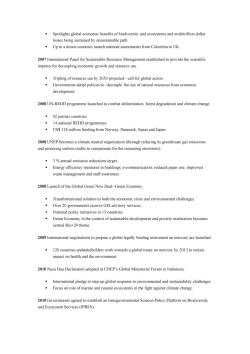
"Spotlights global economic benefits of biodiversity and ecosystems and multitrillion dollar losses being sustained by unsustainable path. Up to a dozen countries launch national assessments from Colombia to UK 2007 International Panel for Sustainable Resource Management established to provide the scientific impetus for decoupling economic growth and resource use. "Tripling of resource use by 2050 projected-call for global action. Governments adopt policies to'decouple'the use of natural resources from economic development. 2008 UN-REDD programme launched to combat deforestation,forest degradation and climate change 42 partner countries. 14 national REDD programmes US$118 million funding from Norway,Denmark,Spain and Japan. 2008 UNEP becomes a climate neutral organization(through reducing its greenhouse gas emissions and procuring carbon credits to compensate for the remaining emissions). "3%annual emission reductions target. Energy efficiency measures in buildings;e-communication;reduced paper use;improved waste management and staff awareness. 2008 Launch of the Global Green New Deal--Green Economy Transformational solution to both the economic crisis and environmental challenges. .Over 20 governments receive GEI advisory services. National policy initiatives in 15 countries. Green Economy in the context of sustainable development and poverty eradication becomes central Rio+20 theme. 2009 International negotiations to prepare a global legally binding instrument on mercury are launched. "120 countries andstakeholders work towards a global treaty on mercury by 2013 to reduce impact on health and the environment. 2010 Nusa Dua Declaration adopted at UNEP's Global Ministerial Forum in Indonesia. "International pledge to step-up global response to environmental and sustainability challenges. Focus on role of marine and coastal ecosystems in the fight against climate change. 2010 Governments agreed to establish an Intergovernmental Science-Policy Platform on Biodiversity and Ecosystem Services(IPBES)
Spotlights global economic benefits of biodiversity and ecosystems and multitrillion dollar losses being sustained by unsustainable path. Up to a dozen countries launch national assessments from Colombia to UK. 2007 International Panel for Sustainable Resource Management established to provide the scientific impetus for decoupling economic growth and resource use. Tripling of resource use by 2050 projected - call for global action. Governments adopt policies to ‘decouple’ the use of natural resources from economic development. 2008 UN-REDD programme launched to combat deforestation, forest degradation and climate change. 42 partner countries. 14 national REDD programmes. US$ 118 million funding from Norway, Denmark, Spain and Japan. 2008 UNEP becomes a climate neutral organization (through reducing its greenhouse gas emissions and procuring carbon credits to compensate for the remaining emissions). 3 % annual emission reductions target. Energy efficiency measures in buildings; e-communication; reduced paper use; improved waste management and staff awareness. 2008 Launch of the Global Green New Deal--Green Economy. Transformational solution to both the economic crisis and environmental challenges. Over 20 governments receive GEI advisory services. National policy initiatives in 15 countries. Green Economy in the context of sustainable development and poverty eradication becomes central Rio+20 theme. 2009 International negotiations to prepare a global legally binding instrument on mercury are launched. 120 countries andstakeholders work towards a global treaty on mercury by 2013 to reduce impact on health and the environment. 2010 Nusa Dua Declaration adopted at UNEP’s Global Ministerial Forum in Indonesia. International pledge to step-up global response to environmental and sustainability challenges. Focus on role of marine and coastal ecosystems in the fight against climate change. 2010 Governments agreed to establish an Intergovernmental Science-Policy Platform on Biodiversity and Ecosystem Services (IPBES)
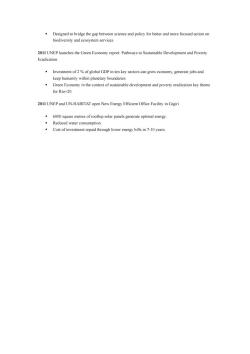
Designed to bridge the gap between science and policy for better and more focused action on biodiversity and ecosystem services. 2011 UNEP launches the Green Economy report:Pathways to Sustainable Development and Poverty Eradication. Investment of 2 of global GDP in ten key sectors can grow economy,generate jobs and keep humanity within planetary boundaries .Green Economy in the context of sustainable development and poverty eradication key theme for Rio+20. 2011 UNEP and UN-HABITAT open New Energy Efficient Office Facility in Gigiri .6000 square metres of rooftop solar panels generate optimal energy. Reduced water consumption Cost of investment repaid through lower energy bills in 7-10 years
Designed to bridge the gap between science and policy for better and more focused action on biodiversity and ecosystem services. 2011 UNEP launches the Green Economy report: Pathways to Sustainable Development and Poverty Eradication. Investment of 2 % of global GDP in ten key sectors can grow economy, generate jobs and keep humanity within planetary boundaries Green Economy in the context of sustainable development and poverty eradication key theme for Rio+20. 2011 UNEP and UN-HABITAT open New Energy Efficient Office Facility in Gigiri 6000 square metres of rooftop solar panels generate optimal energy. Reduced water consumption. Cost of investment repaid through lower energy bills in 7-10 years
按次数下载不扣除下载券;
注册用户24小时内重复下载只扣除一次;
顺序:VIP每日次数-->可用次数-->下载券;
- 《人与环境 Human and Environment》课程教学资源(阅读材料)流浪鸟眼中的世界.doc
- 上海交通大学:《人与环境 Human and Environment》课程教学资源(课件讲稿)第四章 环境与健康(3/3).pdf
- 上海交通大学:《人与环境 Human and Environment》课程教学资源(课件讲稿)第四章 环境与健康(2/3).pdf
- 上海交通大学:《人与环境 Human and Environment》课程教学资源(课件讲稿)第四章 环境与健康(1/3).pdf
- 上海交通大学:《人与环境 Human and Environment》课程教学资源(课件讲稿)第六章 人与环境的展望.pdf
- 上海交通大学:《人与环境 Human and Environment》课程教学资源(课件讲稿)第五章 环境与产业 Environment and Industry.pdf
- 上海交通大学:《人与环境 Human and Environment》课程教学资源(课件讲稿)第二章 全球环境问题.pdf
- 上海交通大学:《人与环境 Human and Environment》课程教学资源(课件讲稿)第三章 人与自然.pdf
- 上海交通大学:《人与环境 Human and Environment》课程教学资源(课件讲稿)第一章 环境学基础(3/3)可持续发展、低碳经济.pdf
- 上海交通大学:《人与环境 Human and Environment》课程教学资源(课件讲稿)第一章 环境学基础(2/3).pdf
- 上海交通大学:《人与环境 Human and Environment》课程教学资源(课件讲稿)第一章 环境学基础(1/3).pdf
- 上海交通大学:《生态规划设计原理》课程教学资源(课堂讲义)08 海绵发展与技术应用.pdf
- 上海交通大学:《生态规划设计原理》课程教学资源(课堂讲义)07 生态评价的内容与方法.pdf
- 上海交通大学:《生态规划设计原理》课程教学资源(课堂讲义)06 生态规划设计相关原理.pdf
- 上海交通大学:《生态规划设计原理》课程教学资源(课堂讲义)05 城乡规划基本原理.pdf
- 上海交通大学:《生态规划设计原理》课程教学资源(课堂讲义)04 城市生态学基本原理.pdf
- 上海交通大学:《生态规划设计原理》课程教学资源(课堂讲义)03 景观生态学概论及基本原理.pdf
- 上海交通大学:《生态规划设计原理》课程教学资源(课堂讲义)02 生态学概论及基本原理.pdf
- 上海交通大学:《生态规划设计原理》课程教学资源(课堂讲义)01 风景区规划的程序及方法.pdf
- 上海交通大学:《生态规划设计原理》课程教学资源(课堂讲义)00 绪论(于冰沁、车生泉).pdf
- 《人与环境 Human and Environment》课程教学资源(阅读材料)[生物入侵案例] 谁杀死了蜂王.doc
- 《人与环境 Human and Environment》课程教学资源(阅读材料)冬季风和夏季风是反相关吗.pdf
- 《人与环境 Human and Environment》课程教学资源(阅读材料)关于敬畏自然的争论.ppt
- 《人与环境 Human and Environment》课程教学资源(阅读材料)热带辐合带对东亚季风的影响.pdf
- 《人与环境 Human and Environment》课程教学资源(阅读材料)生态伦理学——你怎么可以购买大地?.doc
- 《人与环境 Human and Environment》课程教学资源(阅读材料)由中国历史气候记录对季风导致唐朝灭亡说的质疑.doc
- 《人与环境 Human and Environment》课程教学资源(阅读材料)节约能源贵在行动——20种节能方法.pdf
- 《人与环境 Human and Environment》课程教学资源(阅读材料)调查:什么人会反对转基因?14个转基因传闻,你信过几个?.docx
- 《人与环境 Human and Environment》课程教学资源(阅读材料)中国人口变迁.doc
- 《人与环境 Human and Environment》课程教学资源(阅读材料)生物入侵案例——谁杀死了蜂王.doc
- 《生物质能工程》课程教学资源(阅读材料)1.催化热解 Catalytic fast pyrolysis of lignocellulosic biomass.pdf
- 《生物质能工程》课程教学资源(阅读材料)2. 催化热解 Optimizing.pdf
- 《生物质能工程》课程教学资源(阅读材料)3-Effect-of-thermal-acid-alkaline-and-alkaline-peroxide-pretreatments.pdf
- 《生物质能工程》课程教学资源(阅读材料)4-Anaerobic digestion of source-segregated.pdf
- 《生物质能工程》课程教学资源(阅读材料)5-Comparison of solid-state to liquid anaerobic digestion.pdf
- 《生物质能工程》课程教学资源(阅读材料)6-Comparative study of mechanical.pdf
- 《生物质能工程》课程教学资源(阅读材料)7-沼气综述.pdf
- 《生物质能工程》课程教学资源(阅读材料)8-热裂解综述.pdf
- 《生物质能工程》课程教学资源(阅读材料)9-Tony-Review of fast pyrolysis of biomass and product upgrading.pdf
- 南京大学学报(哲学·人文科学·社会科学):改革开放三十年中国环境保护政策演变(周宏春、季曦).pdf
